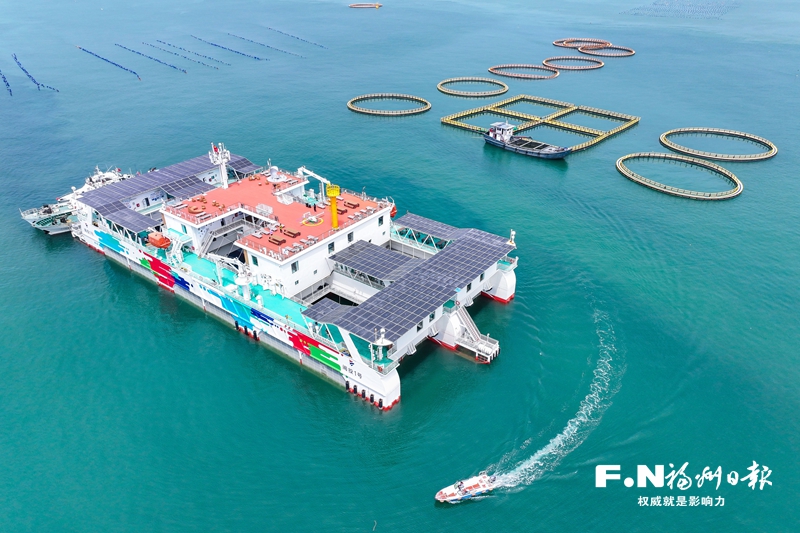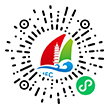The world’s largest 26-megawatt offshore wind turbine has rolled off the production line at the Fujian Three Gorges Offshore Wind Power International Industrial Park, marking a significant advancement in the global leadership of offshore wind power equipment. Built by the Fujian Mawei Shipyard, China's first domestically equipped manned submersible support vessel, “Tansuo 2”, is assisting the “Striver” submersible in completing scientific research missions at a depth of 10,000 meters. In Lianjiang, Fujian’s first “customized offshore fresh food drone safety delivery” application was launched, with the “Minshu 1” drone transporting large yellow croakers from the deep-sea farming platform “Mintou 1” directly to households. Across Fuzhou, the marine engineering equipment industry is progressing rapidly. “Made in Fuzhou” is actively expanding new frontiers for the “Marine Fuzhou” initiative, with high-tech advancements becoming a powerful new engine driving the marine economy.
Advanced equipment paves the way for sea exploration. As the marine economy moves towards deeper, farther, smarter, and greener development, it enters a new phase marked by upgraded development models and optimized industrial structures, with equipment serving as the essential backbone. In recent years, Fuzhou has focused on high-end, intelligent, and green strategies, taking multiple measures to strengthen and enhance industrial chains. This has promoted the high-quality development of the marine engineering equipment industry, contributing to more maritime innovations and intelligent manufacturing, and injecting strong momentum into the “Marine Fuzhou” initiative.
Breaking Waves and Fording Ahead
Shipbuilding Industry Navigating Towards New Horizons
Shipbuilding is not only a traditional strength of Fuzhou’s industry but also a solid foundation and core advantage for advancing the maritime strategy. Located on Reed Island in Lianjiang, the Mawei Shipyard, originally known as the Foochow Arsenal, is the birthplace of numerous firsts in China and even Asia, including China’s first 1,000-ton steamship, the first steel warship, and the first seaplane, among many others.
Currently, the Mawei Shipyard is in full swing, with good news pouring in: the world's largest open-top container ship and Fuzhou’s first RORO ship have been delivered; two 79.8-meter large tuna purse seine boats have been launched; and the dry-docking project for a 700TEU container ship has been completed successfully. “We are building the largest special ship production base in the province, committed to producing various ships for the Belt and Road Initiative countries,” said a spokesperson for Fujian Mawei Shipyard.
Against the backdrop of new quality productive forces and high-quality development, the shipbuilding industry is witnessing unprecedented historical opportunities. To meet the global shipping industry’s development needs, Fujian Mawei Shipyard is actively advancing the process of high-end, green, and intelligent shipbuilding, designing and constructing high-value-added, green, and low-carbon vessels such as RORO ship, thus contributing to Fuzhou’s smart manufacturing.
In July this year, Fuzhou’s first RORO ship, the 7,500-car capacity dual-fuel car-roll-on ship “Minjiangkou”, was successfully delivered and set sail. According to technicians, the vessel incorporates several advanced green technologies, as well as infrared thermal imaging technology, image recognition algorithms, object monitoring algorithms, and edge computing for enhanced digitalization. Specifically, compared to traditional fuel oil car ferries, this ship can save about 20% in energy consumption, and reduce carbon emissions by approximately 27%, nitrogen oxide emissions by 30%, sulfur emissions by 99%, and particulate matter (PM) emissions by over 90%.
The industry is accelerating its shift toward emerging and green technologies. Electric vessels, which can significantly reduce emissions and noise pollution, are emerging as one of the key frontiers in the shipbuilding sector. Fujian’s first large, high-end, fully electric passenger ship, the “Minjiang Living Room,” independently designed and built in Fujian, made its maiden voyage on the Minjiang River. It serves as a model for integrating autonomous research, design, and construction of electric ships in Fujian Province. Additionally, the 5,000-horsepower new energy hybrid tugboat, built by Southeast Shipbuilding, was successfully delivered, becoming China’s first hybrid tugboat to meet the standards for series hybrid power, green ship certification, and smart ship technology, showcasing a high-tech, high-value-added vessel. In recent years, Fuzhou has seen a continuous stream of technological innovations in the electric vessel field, and the “Fuzhou Model” is rapidly taking shape.
From tradition to green, from manufacturing to intelligent manufacturing, and from Fuzhou to the global stage… Fuzhou’s shipbuilding industry is opening up vast new prospects for growth.
Building Momentum
Offshore Wind Turbines Lead the Global Market
Looking out over the coastline stretching along Xinghua Bay, wind turbines rise from the blue sea like towering pillars. As their blades gently turn, a continuous stream of green energy is delivered to millions of households.
Due to the “narrow channel effect” in the Taiwan Strait, the average annual wind speed off the coast of Fujian is between 8 to 9 meters per second, with offshore wind power reaching an average of over 3,500 hours of utilization per year. In June 2015, the Three Gorges Corporation signed a strategic cooperation agreement with the Fujian provincial government, taking a bold step in exploring the transformation of wind power into a valuable resource.
From a barren stretch of coastline, the Fujian Three Gorges Offshore Wind Power International Industrial Park was born. Since 2016, the Three Gorges Corporation has gradually built a world-class offshore wind power industrial cluster here, integrating technology research and development, equipment manufacturing, testing and certification, construction installation, and operation and maintenance.
“Good wind resources require good turbines,” said Sheng Lei, the head of the industrial park. Before 2017, domestic offshore wind turbines had a single-unit capacity of less than 5 megawatts. The Three Gorges Corporation built the world’s first international large-capacity prototype test wind farm in Xinghua Bay’s first phase. They selected 14 turbines from eight renowned domestic and international manufacturers, each with a capacity of 5 megawatts or more, to compete side by side, identifying the most advanced offshore wind power equipment manufacturers to settle in the industrial park.
In July 2017, the main construction of the Fujian Three Gorges Offshore Wind Power International Industrial Park kicked off in Fuqing. Within just two years, the industrial park successfully attracted leading enterprises such as Goldwind, Dongfang Electric, CRRC, China Water Conservancy And Hydropower Engineering Bureau No.4, and LM Glasfiber.
“Look! Right across from our factory is the production workshop of our downstream partner Goldwind. As soon as our generators roll off the production line, they are sent to Goldwind for the assembly of the wind turbines,” said an employee from the Jiangsu CRRC Fuqing branch, located in Three Gorges Offshore Wind Power International Industrial Park. The company primarily manufactures permanent magnet direct-drive generators for offshore wind turbines with capacities of 6 megawatts and above, and currently focuses on providing upstream support for Goldwind.
As China’s first full-industrial-chain offshore wind power industrial park, the Fujian Three Gorges Offshore Wind Power Industrial Park has developed a comprehensive production system, encompassing wind turbines, structural components, turbine assembly, and blade manufacturing. With an annual capacity of 3 million kilowatts, it integrates research, production, and technical services for wind turbines and essential components.
Catching up, keeping pace, and leading the way! From 2019 to the present, in just five short years, the industrial park has successively rolled out China’s self-developed offshore wind turbines with capacities of 6.7 megawatts, 8 megawatts, 10 megawatts, 13 megawatts, 13.6 megawatts, 16 megawatts, 18 megawatts, and 26 megawatts, driving the leapfrog development of China’s offshore wind power equipment manufacturing. This has led to the formation of a complete wind power industry chain and supply chain with leading-edge technology and global competitiveness.

The deep-sea aquaculture equipment “Mintou 1”, located in the Dinhai Bay of Lianjiang. Photo by reporter Yuan Hao.
Advancing into the Deep Blue
Continuous Upgrades in Deep-Sea Aquaculture Equipment
In autumn, from the perspective of a drone soaring high over the Dinghai Bay in Lianjiang, a new landscape of marine farming emerges: the “steel islands” stand firmly in the sea, reshaping the marine ranching pattern; high-tech aquaculture equipment extends the boundaries of the blue economy; and golden-finned large yellow croakers leap joyfully in the vast ocean...
On the vast expanse of the sea, a striking sight draws attention: a massive platform measuring 92 meters in length and 36 meters in width. This is the nation’s first semi-submersible deep-sea intelligent fishing and tourism platform, “Mintou 1.” Equipped with automatic feeding and harvesting systems, it also features video surveillance, water quality monitoring, and 5G communication base stations. Real-time data and parameters are displayed on screens, and through big data analysis, the platform enables automated and intelligent aquaculture operations.
Xu Hang, general manager of Fuzhou Fuyuhui Marine Technology Co., Ltd., which operates “Mintou 1”, explained that, unlike traditional net cages with a depth of 7 to 8 meters, “Mintou 1” uses a semi-submersible marine engineering platform structure, which offers better resistance to wind and waves, allowing the aquaculture depth to reach 25 meters. Due to its offshore location, the dissolved oxygen content in the seawater is higher, providing the large yellow croakers with more spacious living space and an environment where they can breathe freely. As a result, the quality of the fish is superior to that of those raised in traditional net cages.
As aquaculture progresses from nearshore to deep-sea environments, advanced farming equipment becomes crucial. A representative from the Lianjiang County Marine and Fisheries Bureau explained that, for large yellow croakers, wooden fish rafts were the first-generation housing, and plastic fish rafts marked the second generation, both used in nearshore aquaculture. It wasn’t until the third generation of gravity-type deep-water cages and the fourth generation of deep-sea aquaculture platforms emerged that farming areas expanded from the nearshore 200-meter zone into deeper waters, greatly expanding the potential for growth in the “blue economy.” More importantly, this model not only protects the ecosystem but also nurtures resources, accelerating the development of a sustainable and healthy marine fishery system.
To capture the market, staying close to its needs is essential. The “Mintou 1” is equipped with sea-view cabins, an oceanfront restaurant, and other multifunctional spaces. Visitors can enjoy leisure fishing, savor fresh seafood, and take in the sunrise and sunset over the sea. Xu Hang noted that guest rooms are frequently fully booked on weekends, with many visitors coming specifically for the unique offshore leisure experience.
“It was my first time seeing large yellow croakers leaping in groups up close, my first experience with the thrill of sea fishing, and my first time fulfilling my sailing dream right at my doorstep,” said Chen Qingling, a tourist who recently drove with his family from downtown Fuzhou to experience the charm of “Mintou 1”. “The freshly caught and cooked yellow croaker was incredibly delicious. Next time, I’ll bring my employees for a group visit!”
Fuzhou was born from the sea and thrives through the sea. In recent years, Fuzhou has accelerated the transformation and upgrading of its marine fisheries industry. The city has taken the lead in the province by developing “hundreds of units, millions of tons” of deep-sea aquaculture equipment, adopting an industrial approach to build “offshore granaries,” and driving the transition of traditional aquaculture to the 3.0 version of marine ranching, characterized by digitization and systematization. Currently, the city has deployed 11 sets of deep-sea aquaculture platforms, including “Mintou”, “Dinghai Bay”, and “Qiandong”, ranking first in both the number of platforms deployed and those in operation nationwide. This serves as an important model for promoting deep-sea aquaculture platforms in the province and across the country.
Aiming for cutting-edge innovation, Fuzhou is exploring the deeper seas, and continuing the legacy of shipbuilding. New forces of momentum are surging through the vast blue waters of Fuzhou, composing a new chapter in the era of maritime strength. (Fuzhou Daily, reporter Yan Lanping. Photo by Yuan Hao)







